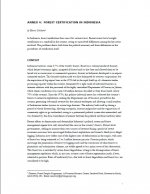A New Agenda for Forest Conservation and Poverty Reduction
Making Markets Work for Low-Income Producers
By Sara J. Scherr, Andy White, David Kaimowitz - Forest Trends, Forest Trends, CIFORThe future of the world’s forests and the future of millions of the world’s poorest people are inextricably linked. Rural poverty is concentrated in many areas where the world’s biodiversity is most threatened. More than a billion people now live within the world’s 19 forest biodiversity “hotspots” and population growth in the world’s tropical wilderness […]
Case Studies of Markets and Innovative Financial Mechanisms for Water Services from Forests
This paper examines existing market and financial mechanisms that are being used to provide hydrological services from watersheds and to assist forest owners and policymakers in assessing the advisability and feasibility of using such mechanisms.
Forestry in China
Policy, Consumption, and Production in Forestry's Newest Superpower
By Jintao Xu, Andy White, Gary Bull, Sten Nilsson, eds. - Center for Chinese Agricultural Policy, Forest Trends, University of British Columbia, IIASAChina’s forest market is one of the largest in the world in terms of production, consumption, and imports of wood products. Its large forest estate and massive population has meant that it has also for some time been a leading nation in terms of the number of processing plants, number of people employed in the […]
Dependent Documents
An Assessment of China’s Forest Resources
By Gary Bull , Sten Nilsson - University of British Columbia, IIASA, Forest TrendsChina’s Pulp and Paper Sector
An Analysis of Supply-Demand Trends and Medium-Term Projections
By Dequan He , Chris Barr - China Economic Consulting, Inc, CIFOR, Forest TrendsChina’s Development of a Plantation-based Wood Pulp Industry
Government Policies, Financial Incentives, and Investment Trends
By Chris Barr , Christian Cossalter - World Agroforestry Centre, CIFOR, Forest TrendsChina’s Forest Sector Markets
Policy Issues and Recommendations
By Sten Nilsson, Gary Bull, Andy White, Jintao Xu - IIASA, University of British Columbia, Forest Trends, CCAPUnderstanding the Chinese Forest Market and Its Global Implications
By Jintao Xu , A. White - Chinese Agricultural Policy, Forest TrendsThe China Forest Products Trade
Overview of Asia-Pacific Supplying Countries, Impacts and Implications
By Eugenia Katsigris, Gary Bull, Andy White, Chris Barr, Keith Barney, Yati Bun, Timothy King, Alexey Lankin, Anatoly Lebedev, Phil Shearman, Alexander Sheingauz, Fredrich Kahrl, Yufang Su, Horst Weyerhaeuser - Forest Trends, University of British Columbia, Forest Trends, Center for International Forestry Research, York University, Foundation for People and Community Development, Forest Information Systems, Far Eastern Ecoregional Project, Worldwide Fund for Nature, Bureau for Regional Oriental Campaigns, University of Papua New Guinea, Economic Research Institute, Russian Academy of Sciences, World Agroforestry Centre, World Agroforestry Centre, World Agroforestry CentreChina’s Collective Forestlands
Contributions and Constraints
By Guangping Miao , R. Anders West - FEDRC, Forest TrendsEmail Signup
Subscribe to any of Forest Trends’ mailing lists to keep up with the news, publications, and events that interest you.
Having Trouble?
If you experience any technical difficulties on our site, please contact Genevieve Bennett, Communications Manager.
Markets for Biodiversity Services
Potential Roles and Challenges
By Michael Jenkins, Sara J. Scherr, and Mira Inbar - Forest Trends, Forest Trends, Forest TrendsIn recent decades, several factors have stimulated those concerned with biodiversity conservation services to begin exploring new market-based instruments. The model of public finance for forest and biodiversity conservation is facing a crisis as the main sources of finance have stagnated, despite the recognition that much larger areas require protection.
Who Conserves the World’s Forests? A New Assessment of Conservation and Investment Trends
By Augusta Molnar, Sara J. Scherr, Arvind Khare - Forest Trends, Ecoagriculture Partners, Forest TrendsThe current system of protected areas continues to be severely under-funded while not including enough of the world’s priority biodiversity and natural habitats. At the present coverage and quality of protection, biologists estimate that only 50-70% of the existing species will be conserved. It is the thesis of this paper that current proposals for expanding […]
Dependent Documents
Who Conserves the World’s Forests? Community-Driven Strategies to Protect Forests and Respect Rights (Policy Brief)
By Augusta Molnar, Sara J. Scherr, Arvind Khare - Forest Trends, Ecoagriculture Partners, Forest TrendsChina Softwood-Log Commodity Chain and Livelihood Analysis
From the Russian Far East to China
By Alexander Sheingauz, Anatoly Lebedev , Natalia Ye Antonova - Economic Research Institutental Campaigns, Bureau for Regional Oriental Campaigns, Forest Trends, CIFOR, DFIDChina has rapidly become one of the world’s largest importers of wood. The volumes of logs, sawn wood, wood panels, and pulp and paper products shipped to China by producer countries in Southeast Asia, the Russian Far East (RFE), Siberia and other regions have grown especially sharply since China implemented a partial ban on logging […]
Illegal Forest Activities in the Asia Pacific Rim
By Arnoldo Contreras Hermosilla - Forest TrendsIllegal forest activities within the Asia Pacific countries have generated a host of negative impacts on the economy, the poor, and the quality of forest management. It is in the interest of all of the stakeholders – from local communities to national politicians to logging companies to international donors – to work together to ensure […]
An Overview of the Market Chain for China’s Timber Product Imports from Myanmar
By Fredrich Kahrl, Horst Weyerhaeuser, and Su Yufang - World Agroforestry Centre, World Agroforestry Centre, World Agroforestry Centre, Forest Trends, DFID, CIFORChina’s annual timber product imports from Myanmar more than tripled between 1997 and 2002. Although imports from Myanmar comprise just over two percent of China’s total timber product imports, the nascent increase in logging activities along the Chinese border in Myanmar has been highly concentrated in natural forests in Myanmar’s northern Kachin State, and the […]
Certification in Complex Socio-Political Settings
Looking forward to the Next Decade
By Michael Richards - Forest TrendsThere is little evidence of certification’s impact on checking illegal logging, corruption and other severe forest governance problems. This is not surprising since these problems derive from problems in the legal, regulatory and policy framework, and public respect for law and order – problems unlikely to be much affected by a market instrument (with a […]
Dependent Documents
Annex 4: Forest Certification in Indonesia
By Marcus Colchester - Forest Peoples Programme, Forest TrendsAnnex 1: La Experiencia Boliviana en la Certificación Forestal
By Henry Moreno Sanjines - Forest TrendsAnnex 2: Brazil Forest Certification Case Study
By Andre de Freitas - IMAFLORA, Forest TrendsAnnex 3: West and Central Africa
Progress and Prospects for Forest Certification
By Mike Packer - Timbmet Group, Forest TrendsAnnex 5: Forest Certification in Malaysia
By Saskia Ozinga - Forest TrendsAnnex 6: The Experience of the Russian Producers’ Group
By Andrey Ptichnikov - Forest TrendsAnnex 7: Priluzye Model Forest Certification Case
By Mikhail Karpachevskiy - Forest TrendsForest Products Trade Between Russia & China
Potential Production, Processing, Consumption and Trade Scenarios
By Steven Northway , Gary Q. Bull - University of British Columbia (UBC), Forest Trends, Rights & Resources Initiative (RRI)This synthesis report depicts future trends in forest products processing, consumption and trade between China and its main suppliers, with a particular focus on Siberia and the Russian Far East. It is based on the findings of the International Forest and Forest Products (IFFP) trade model analysis completed by Northway & Bull 2007. The first […]

























